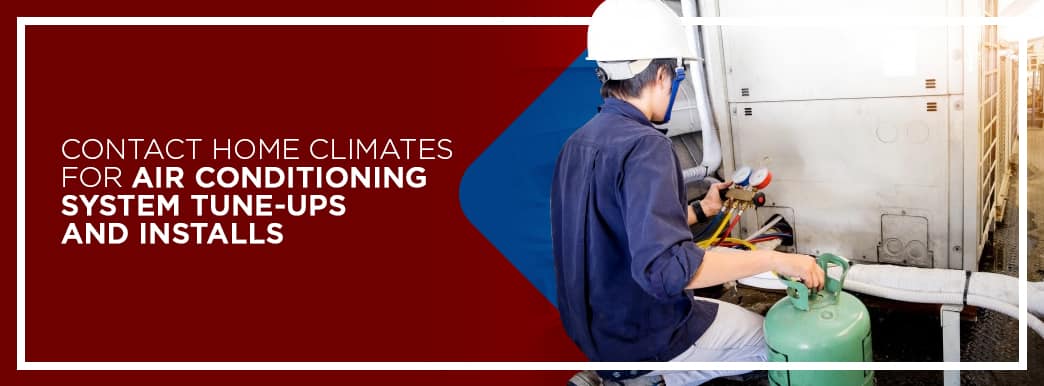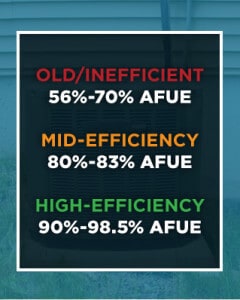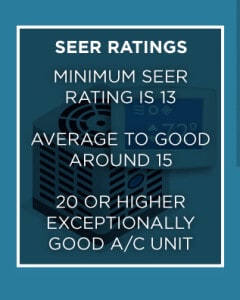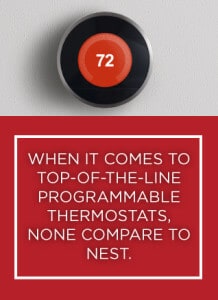When to Upgrade Your Air Conditioning or Heating System
Mar 29, 2017

Heating and cooling systems are an essential part of being a Central Pennsylvania homeowner. Considering the seasonal climates in the region — with both cold winters and summer heat — having an efficient HVAC system is crucial if you are going to live comfortably.
However, many homeowners also take their HVAC systems for granted. As long as they appear to be working, homeowners are all too often content to leave them alone. What you may not know is that as you near the end of an HVAC system’s lifespan, you may be losing money due to system inefficiency. Your AC may be running harder just to bring down the temperature on your thermostat and you may find that your gas bills are rising even if the winter isn’t necessarily any harsher.
In other words, even if it isn’t broken, it may still be time to consider an air conditioning or heating system upgrade.
That’s why we’re putting together this guide on when to upgrade an HVAC system. Included will be a discussion of the many signs of an aging HVAC system, as well as some of our favorite efficient HVAC solutions.
So, let’s see if you are indeed due for a heating or air conditioning upgrade.
An Overview of Efficiency Ratings for Boilers and Furnaces
The key metric for measuring the efficiency of a boiler or furnace is annual fuel utilization efficiency (AFUE). This metric, displayed as a percentage, indicates the portion of the heating fuel that’s directly converted into heat. Keep in mind, this number does not account for heat loss due to insulation or aging duct work.
 Thankfully, the Federal Trade Commission now requires all new furnaces and boilers to display their AFUE. Unfortunately, some homes are still using boilers or furnaces that predate this regulation. However, a furnace that old is likely relatively inefficient. You can also estimate its peak performance efficiency by looking at what kind of equipment is onboard.
Thankfully, the Federal Trade Commission now requires all new furnaces and boilers to display their AFUE. Unfortunately, some homes are still using boilers or furnaces that predate this regulation. However, a furnace that old is likely relatively inefficient. You can also estimate its peak performance efficiency by looking at what kind of equipment is onboard.
Here are the three AFUE levels as stated by energy.gov:
- Old/Inefficient (56% to 70% AFUE):
These systems utilize a continuous pilot light, meaning that a portion of heating fuel is consumed merely to keep the pilot light on. They also have a natural draft, which means some combustion gases are vented. They also feature a heavy heat exchanger.
- Mid-efficiency (80% to 83% AFUE):
These systems use a vent fan to prevent the venting of combustion gases. Additionally, they feature a narrow flue pipe. They also don’t have a pilot light, opting instead for electronic ignition.
- High-efficiency (90% to 98.5% AFUE):
In addition to the features in a mid-efficiency furnace, these ultra-efficient boilers and furnaces incorporate sealed combustion and a second heat exchanger to reuse condensing flue gases.
Keep in mind that high-efficiency furnaces and boilers do more than save you money. According to energy.gov, a high-efficiency furnace will save 1.5 tons of carbon emissions per year if you use gas or 2.5 tons if you use oil when compared to an old, inefficient system.

Finally, a boiler or furnace will only be as efficient as advertised if it’s well maintained and attached to an equally efficient duct system. So, make sure you think beyond the boiler!
Symptoms of an Inefficient Boiler/Furnace
While knowing your boiler/furnace’s AFUE is the quickest way to measure its efficiency, there are other ways to diagnose an inefficient system. Here are some basic clues that you may be overdue for an upgrade.
- Your furnace/boiler room is hot:
An efficient boiler won’t emit much heat, since it’s being pushed through your home instead. Your heater also has an idle mode. If you are experiencing high idle losses, especially during the non-winter months, you could find considerable savings by upgrading your system.
- Your furnace is oversized:
You may not realize that a furnace that runs in short cycles and thus is regularly turning off and on is actually more inefficient. If you furnace is cycling on and off at high frequency, it’s likely because your furnace is oversized for your home. All of this cycling can also contribute to high idle losses, meaning frequent cycling and a hot boiler room could be related.
And there really isn’t any way to fix this problem except through a total replacement. In fact, even if you aren’t sure if your furnace is properly sized, but you’re looking to replace it anyway, make sure to confirm with a professional that your new furnace is appropriate. Simply replacing one furnace with another of the same size may not be wise, as you may have been running an oversized furnace without even realizing it!
- Your furnace has a pilot light:
Newer, more energy-efficient furnaces use electrical starts, thus eliminating the need for a pilot light, which is constantly consuming a small amount of gas or oil in order to stay lit. If your heater has a pilot light, this is a clear sign you’re using a boiler or heater that’s old and inefficient. It may seem like a small thing, but over the course of a year or two, that wasted energy can definitely add up!
- Your ductwork is poorly insulated:
While inefficiency often starts with your furnace, poorly insulated ductwork can sap the efficiency of even the greenest boiler. Before you take steps to upgrade your boiler, make sure your ductwork is also in order.
It’s not uncommon for ductwork to remain uninsulated in the basement. However, since basements are typically unheated, you can experience tremendous energy losses in just this area alone. Fortunately, since basement ductwork is often exposed, it’s also easy to add insulation without doing a complete reinstallation of your ductwork.
Don’t Neglect Your Air Conditioning Unit
While our previous discussion has focused on furnaces and heating systems, those of us in Central Pennsylvania know that a good air conditioning unit is essential for comfort come summertime. Here are some essential considerations where air conditioners are concerned.
Seasonal Energy Efficiency Ratio (SEER)
 While heating systems are measured in terms of fuel to heat, measuring air conditioning efficiency is a little more complicated, since central air units are powered with electricity rather than oil or gas. In order to get a sense of the efficiency of your unit, you need to become familiar with its seasonal energy efficiency ratio (SEER).
While heating systems are measured in terms of fuel to heat, measuring air conditioning efficiency is a little more complicated, since central air units are powered with electricity rather than oil or gas. In order to get a sense of the efficiency of your unit, you need to become familiar with its seasonal energy efficiency ratio (SEER).
Because you’re only using your AC during the warmer months, SEER takes into account the percentage of electricity usage that’s dedicated to AC operation. However, this calculation is a little complicated, so the important thing is to remember what numbers are considered good and which are subpar.
If you’re buying a new unit, a 13 SEER rating is now considered the minimum. Average to good SEER ratings hover around 16. With today’s newer compressor technologies, higher efficiency air conditioners are now reaching 20 SEER and higher. These units would cut your air conditioner electric usage in half!
However, keep in mind that these minimums have only been recently established. If you have an older unit, it could be running with a SEER rating of 10 or lower! If so, you should definitely consider replacing your air conditioner, even if it’s in working order just based off of your electricity savings.
Energy Efficiency Requires Regular Maintenance
While your air conditioner may have an official SEER rating of 16, if you neglect it, its actually rating could become much lower.
There are a couple of areas that require regular attention. First, you want to make sure your electrical connections are in good shape. If they’re starting to corrode, you may find that your unit has functionality issues. Furthermore, fixing electrical issues before they break is a lot cheaper than a total replacement.
Second, you want to make sure that debris and dirt buildup aren’t sapping your unit’s efficiency. This type of regular maintenance is difficult for most homeowners, so regular service contracts are a great way to keep the buildup at bay!
Be Sure to Use a Modern Refrigerant
While this doesn’t necessarily concern energy efficiency, for those who want their air conditioners to be eco-friendly, you need to make sure you’re using a modern refrigerant.
One of the most popular refrigerants used in older air conditioners was R-22, or Freon. This refrigerant can no longer be used in air conditioners manufactured after 2009, as it’s a leading contributor to the depletion of the ozone layer. Instead, modern units use a refrigerant known as R-410A.
If you have an older unit, note that you’ll have a hard time finding R-22 in order to recharge your system and it is going to continue to get more expensive. At this point, it must be reclaimed from other preexisting units.
That being said, such an old unit is also likely to have other issues, so a complete replacement and upgrade may be your most cost-effective choice!
There Have Been Significant Recent Technological Advancements
While we want to get the most value out of our existing appliances, it’s also important to note that recent technological advancements have made drastic improvements to air conditioning units, especially in terms of energy efficiency. Even if your unit is functioning well, it may still be cost-effective to upgrade, considering how much you can save on electrical bills throughout the summer.
If you’re curious about the savings you might be missing out on, contact a sales representative who can do a data comparison between your current unit and a new, higher-efficient air conditioner.
Some Other General Tips for HVAC Replacement and Repair
There are a number of things to consider when evaluating your HVAC system. However, there’s also some general advice that we want to make sure to include. These tips apply to both air conditioners and furnaces.
- The 5,000 rule:
At a certain point, even a small repair stops being worth it in the long run. That’s why it’s good to use the 5,000 rule to determine if you should pay for a repair or invest in a new unit.Simply multiply the age of your unit by the cost of the repair. If that number is equal to or greater than 5,000, you should definitely consider replacing the unit. So, if a five-year-old unit needs a $500 repair, you’d be wise to stick with your existing unit. However, if that unit is 10 years old, the same repair is no longer cost-effective and Home Climates can help you to figure that out.
- Rebates and tax credits:
The federal and local government wants to encourage homeowners to install high-efficiency units in order to cut into the amount of carbon the nation is releasing into the atmosphere. As such, Home Climates can let you know what kind of tax breaks and rebates are being offered.While you might not be in a place to replace an aging unit on your own, with a tax break, an upgrade suddenly becomes much more affordable! There are even some special manufacturer rebates available that we can show you.
 Install a programmable thermostat:
Install a programmable thermostat:
Whether you’re heating or cooling, a programmable thermostat is a great way to get much tighter control over your home’s climate.When it comes to top-of-the-line programmable thermostats, none compare to Nest. This smart technology learns your climate preferences and habits, is easily programmed when you leave on vacation and can even be controlled from a smartphone. Imagine coming home from visiting family over the holidays and being able to kick the heat on an hour before you get home, insuring your house is toasty as soon as you get in the door!For data heads, Nest even provides a monthly energy efficiency report, which will allow you to track your energy use and squeeze even more savings out of your HVAC system.
- Improve your home’s market value:
Finally, if you’re looking to sell your home in the near future, a new unit can make your house more attractive to potential buyers.When buyers tour homes, they note the things they may have to repair or replace as soon as they move in. More and more, homebuyers are especially hawk-eyed in terms of energy savings and eco-friendly appliances.A new furnace or AC unit is a great way to ease a buyer’s mind and potentially convince them to purchase your house. Furthermore, home inspectors pay special attention to air conditioners and boilers, so you definitely want to avoid getting a bad inspection right before a buyer is supposed to sign on the dotted line!
Trust Home Climates with your HVAC upgrades
If you live in Central Pennsylvania and you’re ready to explore either a furnace or air conditioner repair or replacement, look no further than Home Climates!
If you’ve gone years without a tune-up or an inspection, we’re happy to come out and give your AC system a look. That way, you can either make the adjustments you need to ensure your system is working at peak efficiency or you can begin exploring replacement options. There isn’t a brand or make that we can’t service! We even offer priority scheduling without any upcharge for after-hours or holiday visits if you are an Easy Care member!
If you do decide to upgrade, our expert and courteous installation professionals will make sure you’re getting the right unit for your house installed properly. We even offer consumer-friendly financing options to make the cost of an upgrade easier on you.
So, if you’re ready to get the most efficiency possible out of your heating or cooling, contact us today!
